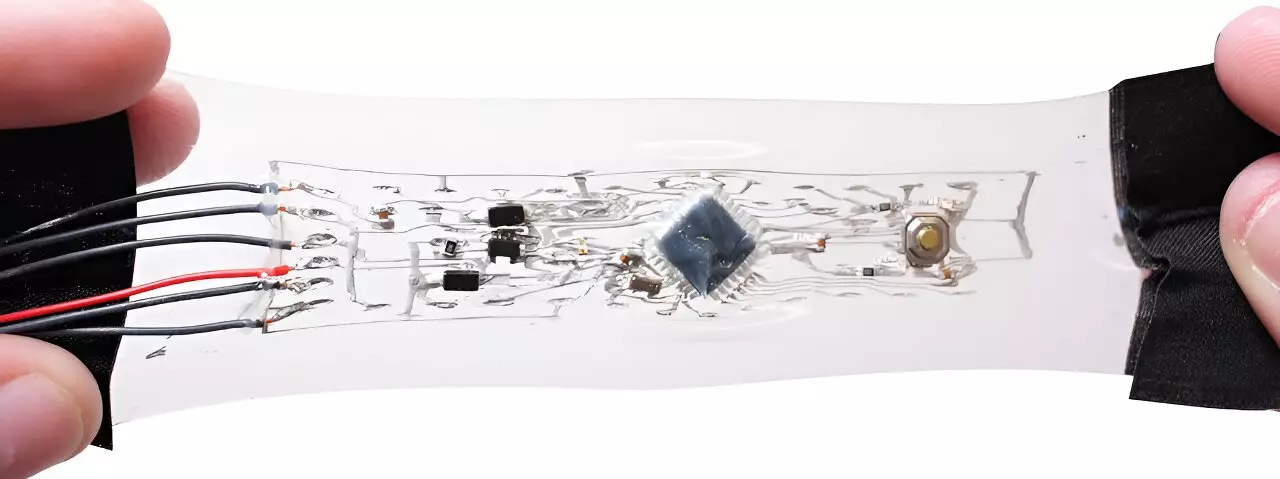The intersection of soft robotics and wearable technology is an emerging field that promises innovative solutions in various sectors, from healthcare to search-and-rescue operations. However, one of the critical challenges faced by researchers and engineers is creating devices that retain functionality while being flexible and stretchable. Researchers in Professor Rebecca Kramer-Bottiglio’s lab have made significant strides in this area, developing advanced stretchable electronics that address the rigid-flexible dilemma often encountered in soft robotic designs.
Challenges in Soft Robotics and Wearable Electronics Design
The inherent disparity between the rigid components needed for electrical circuitry and the soft materials utilized in soft robots often leads to complications in design. Traditional robotics typically depend on rigid microcontrollers, such as Arduino platforms, which are not suited for integration with stretchable materials without sacrificing the robot’s intended functionality. This constraint forces designers to position their electronics in a manner that minimizes interference with the robot’s movement, which can limit design creativity and operational efficiency.
The researchers in Kramer-Bottiglio’s lab tackled this issue head-on by developing a stretchable version of the Arduino, a popular open-source hardware platform. Their innovations not only represent a breakthrough in the field but also offer a pathway for other developers to create more versatile and functional soft robotic systems.
A notable aspect of this research is the advanced manufacturing techniques employed to produce these stretchable electronics. The team utilized a gallium-based liquid metal that could be transformed into a paste, enabling it to be easily applied to various substrates. This approach represents a significant improvement over traditional methods that often require complex equipment and extensive technical knowledge.
By laser-cutting paper into specific circuit patterns, the researchers created masks that allowed for precise application of the liquid metal. This ingenuity ensures that the resulting circuits can flex and stretch, maintaining performance while also adhering firmly to both soft and rigid components. The result is a complex, multilayered circuit that can stretch to three or even four times its original size.
The impact of these developments extends well beyond academic curiosity; the researchers demonstrated how their stretchable circuits can be applied in various real-world scenarios. Among the applications highlighted was the integration of these circuits into soft robots that mimic animal movements. For example, one prototype controlled the gait of a quadruped robot without hindering its ability to morph and adapt to varying terrain.
Moreover, the potential for wearable devices is significant, particularly for therapeutic applications. One specific example provided was applying a stretchable circuit on the elbow, an area that experiences considerable movement. Such devices could offer critical assistance to those rehabilitating from injuries, providing support while allowing for the natural range of motion that is essential for recovery.
A standout feature of this research is the commitment to openness and accessibility; all materials, methods, and circuit designs are open-sourced, allowing for greater collaboration and innovation in the field. This open-source approach could accelerate advancements in soft robotics and wearable devices, providing a platform for hobbyists, researchers, and engineers alike to build upon and refine the team’s work.
The researchers have laid a solid foundation for the future of stretchable electronics, but the journey does not end here. Moving forward, potential avenues for exploration include enhancing the scalability of these systems and addressing more complex applications. Questions remain about the long-term durability and reliability of stretchable circuits in extreme conditions, and further research is needed to optimize these designs for mass production.
The developments in stretchable electronics by Kramer-Bottiglio’s lab signify a seminal step toward the future of robotics and wearable technology. By overcoming the limitations imposed by traditional rigid circuits, the researchers have opened doors to more dynamic, adaptable designs that offer enhanced functionality without sacrificing performance. As the field continues to evolve, the integration of these innovations could redefine the possibilities for both soft robots and wearable devices, ushering in a new era of technology that is not only functional but also seamlessly integrates with the human experience.


Leave a Reply